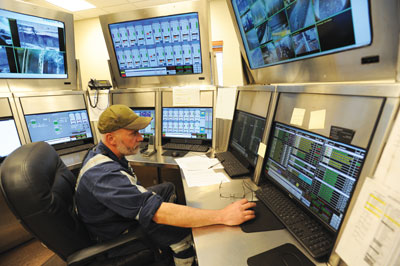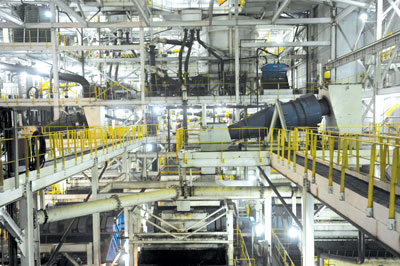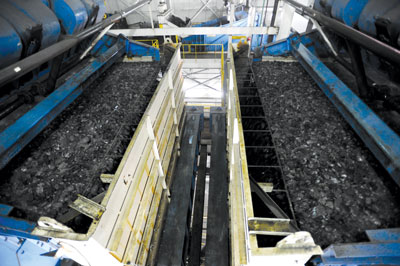TECHNOLOGY, CUTTING-EDGE DESIGN, EXPERIENCE COME TOGETHER TO EXEMPLIFY PROCESSING SUCCESS
By Donna Schmidt, Field Editor
| The 1,400-tph Leer prep plant incorporates a duplicate circuit design to produce a met and steam product. |
Just a few thousand feet from U.S. Route 50 and Three Forks Creek that parallels it in the foothills of the northern West Virginia panhandle, and just downhill from a new longwall mine, sits a state-of-the art preparation facility that could serve as a model for other preparation facilities.
When faced with strong headwinds, businesses often react one of two ways: run from problems and surrender, perhaps waiting to be forced out, or view the time as an opportunity to face the challenges head-on, adapt and relentlessly seek out new goals. ACI Tygart Valley’s Leer preparation plant, an Arch Coal subsidiary, in Grafton — part of the Leer mining complex in Taylor County — has clearly done the latter and is becoming the epitome of strength, flexibility and persistence.
The steel construction Leer Prep Plant, which totals approximately 93,000 square feet and 7.5 stories, was erected by Powell Construction. Work took just over a year, commencing in September 2011 and wrapping up in October 2012, just in time to accept tonnage from the newly finished Leer underground operation and just months before Leer’s longwall would take its first pass and ramp up the pace of preparation. Arch Coal Director of Preparation Greg Dehart was a central visionary behind the plant’s design.
It did not take long before the heavy media cyclone facility was at peak, 1,400 tons per hour, and Plant Manager Randall Corder makes sure that goal is met safely and efficiently. Corder, a four-year Arch veteran with 18 years of preparation experience, was also present to load one of the first rail cars from the Leer loadout when that portion of the complex shipped its first coal in late October 2012.
According to management, those design features which were important to include in Leer are the very same aspects that make the facility unique and unlike most other currently active preparation plants. At the center of that is a two-stage design on the facility’s heavy media cyclone circuits, reflux classifying circuits and desliming circuits. The two are split vertically under the plant’s massive roof to allow for both a low-ash metallurgical product and a higher-ash middlings product to be produced; -2”x1mm to HM cyclones, -1mmx100M to the reflux classifiers and -100Mx325M to column flotation. The resulting products are then sent to independent stockpile for loading.
 |
| The loadout team can load a train of as many as 130 railcars at 4,000 tons per hour. |
 |
| The plant operator can monitor all activity from a control room that acquires data in real time from a network of PLCs. |
“The rewash circuits incorporated in the design of the plant are unique to coal preparation,” Corder said of the circuit design. It also keeps production steady during times of needed maintenance, when one side of the building can be working as normal while another is being serviced; the vertical design makes such tasks even easier and safer for all involved and allows proper room for personnel movement in nearly every corner of the building.
Other technical facets that keeps Leer moving along at peak production and high coal recovery include the reflux classifiers’ hydraulic separation process in the fine coal circuit to reduce ash and two-stage column flotation cells in the ultra-fine side for the most efficient recovery of metallurgical coal.
The facility’s safety features are unparalleled. A small transport elevator that can carry staff and parts to any level of the plant, along with installed accesses to the building’s lighting system, are both just the beginning of the work designers and Arch staff put into the plant.
“Plant design incorporates overhead cranes for safety as well as efficiency,” Corder said, noting that the coarse side of the plant uses a 15-ton bridge crane to access the 14-foot-wide vibrating screens and the heavy media cyclones.
On the fine side, the plant has a 10-ton bridge crane that can access the head drive area of the plant feed belt as well as its raw coal classifying cyclones and the magnetic separators.
“Both cranes also have a hoistwell that extends to the bottom of the plant,” he added.
It is evident in examining Leer’s equipment that special attention was paid to keeping regional ties with vendors, another nod to overall efficiency. While Ludowici provided the course coal centrifuges, there are also several Appalachian vendors including the Kanawha Scales batch weigh train load-out system. Other central fleet products include Conn-Weld screens, Krebs primary heavy media and classifying cyclones, Multotec secondary heavy media cyclones, Warman pumps from Weir, Eriez column flotation cells and magnetic separators and Decanter screen bowl centrifuges.
“Equipment performance and customer service is always at the top of the list when choosing an equipment vendor,” Corder said.
With new construction came the ability to choose cutting-edge technology, and that is evident both inside and outside the facility. The plant is currently using chromed stainless screen media for most applications. It also has placed a 140-ft Eimco thickener with fully automated turbidity control and settling rate control.
Environmental considerations were a large part of those technology selections, from magnetite consumption — which Corder confirmed is maintained below industry standards — and its refuse area. Leer does not have a filter press; it instead has incorporated a slurry cell at the coarse refuse site and uses screen bowl centrifuges to dewater the -1mm product and centrifuges to dewater product exceeding 1mm.
Finally, the Leer system as a whole incorporates alkaline lime sand into both the coarse and fine refuse to allow neutralization of the slurry that commonly comes with the territory of the sulfurous coal from the Lower Kittanning seam.
 |
| Large diameter heavy media cyclones make the initial coarse coal cut. |
 |
| The plant has two of everything, including these drain-and-rinse screens. |
The Power of Technology — and People
At the heart of Leer Prep is a control room that has been efficiently organized as the plant’s central dispatch and monitoring center; using AxacqVision, virtually every inch of the building’s interior and exterior is under the watchful eye of one of the facility’s six men that work each of the 12-hour shifts (three days on, two days off, each shift staff is split between preparation duties, the loadout and the refuse area).
Automation was a big art of the technology selection in this area, according to Corder.
“The PLC controls keep the different processes at operating set-points automatically,” he said. “Trends and historical data can also be accessed from the plant computers. There are also several cameras throughout the process to help monitor different areas.”
Overseeing a team of 23 hourly employees, Corder said that putting together the Leer Prep team involved nearly as much planning as the plant design itself. Experience levels at the facility now range between less than one year to more than 25 years, which he said is an ideal mix for sharing experiences and technologies as well as passing along skill sets and best practices.
A main goal from the personnel perspective was cross-training to permit any job at the plant or refuse area to be performed by anyone, and so far that goal is being met. Currently, about 60% of the workers have been cross-trained for everything from serving as the facility’s single floor operator, electronic troubleshooting and monitoring duties to the most complex maintenance tasks on the site.
“It is my goal to have all employees cross trained on all the different plant tasks,” Corder said, noting that the team is well on its way.
The Leer Loadout
After following miles of underground conveyor beltline into and then out of the Leer Prep facility, the coal is ready to head out on its way to a sizeable collection of both domestic and international customers — all by CSX rail. While Leer management does not disclose specific customers, they estimate a majority of the coal leaves the mine for loading at Curtis Bay export facility in Baltimore, just a few hours away. The remaining shipments are split among the Hampton Roads/Norfolk DTA export complex and several domestic customers who also receive both straight and blended deliveries by railcar.
The already-impressive Leer Prep has nothing less than the best in loading facilities to complement its hard work. The loadout team can load a train of as many as 130 railcars at 4,000 tons per hour.
Arch built the rail line in 2012 to aid with the logistics of processing and delivery; its own line extends about 3.5 miles from Grafton to the neighboring town of Thornton.
Specific coal orders can be blended on-site thanks to the state-of-the art analyzer system; however, its straight products are impressively versatile on their own as a low-cost, High-Vol A metallurgical coal.
It is no secret that success is hard to come by. How one navigates the route to success can vary, but no one would disagree that a concerted effort to achieve and exceed goals is top priority. For Leer Prep, that success is the safe and efficient way in which its staff operates the plant so that it can hit targets and still celebrate the ability to send everyone home safely to their families on a daily basis. In fact, its safety mission has been recognized both regionally and nationally, most recently with a Mountaineer Guardian Award for its exemplary safety performance in 2014.
“The safety performance at the Leer prep plant is a reflection of hardworking employees,” Corder said of its safety focus and achievements. “Our proactive behavior-based safety approach enlists all of our employees to identify and eliminate at-risk behaviors and reinforce best safety practices. Working safely is truly a team effort.”




